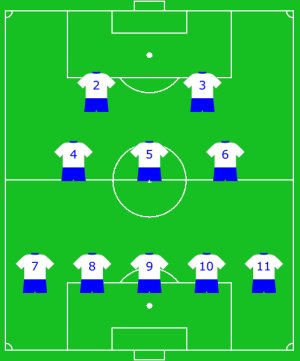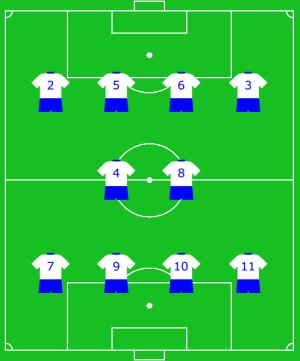In the course of a conversation with a friend (hard to believe, we accept, that running a blog like this is not a complete impediment to positive human interaction) last week, we came to a realisation that not everybody has a base understanding of why certain numbers belong in certain positions.
He has a Gaelic football background (where teams of 15 generally line out in five lines, numbered 2-15 in order) and cited as an example that he was confused why 2 and 3 are traditionally at the opposite sides of the field in football. As a result, we were inspired to compose this post, the first of a series on the history and evolution of shirt numbering in football.
While numbers were first used in English league football by Arsenal and Sheffield Wednesday in 1928, that was a one-off experiment it wasn’t until the 1933 FA Cup final that they gained wider notice, Everton wearing 1-11 and Manchester City 12-22. They became permanent the following season, and ran logically, according to the 2-3-5, or pyramid, system in fashion then. Numbers 2 and 3 were the full-backs, a term which remains today.
By the 1930s, however, 2-3-5 was already dying out, with many teams switching to what was known as the W-M formation, dropping an extra player back to deal with changes in the offside laws. By and large in Britain, it was the central player of the three half-backs who was placed between the full-backs but kept the number 5. Like full-back, centre-half is a term which remains despite its meaning having changed.
While the 3-3-4 was briefly in vogue, with the number 8 playing alongside 4 and 6 in what was now known as midfield, Brazil’s winning of the 1958 World Cup with a 4-2-4 prompted others to try to ape that system. In Britain, it was usually the left-half who was withdrawn into central defence alongside 5.
While leading to attacking football, the 4-2-4 wasn’t the most defensively solid of formations and so, gradually, the wide forwards, 7 and 11, came to play deeper as well. This gave us the 4-4-2.





Ah, thank you for this. I’m sure Inverting the Pyramid is excellent, but this bitesize chunk is all I needed.
A couple of things: Firstly, doesn’t this make for a very strong argument for a whole host of your own bugbears? 2 and 3 being worn by centrebacks? 5 and 6 in midfield? With all the new-fangled formations (and 4-4-2, which you seem to view as the blueprint, so rarely seen nowadays) shouldn’t a nod to any bygone era be applauded?
Secondly, prior to a schools football match at the age of 11 – my first 11-a-side game, I believe – positions were quickly allocated just before kickoff. The question was asked “Who wants to play centre-half?” and, having never heard the term before, I assumed this meant “centre midfield”. The manager was happy (I didn’t understand why me being “a tall lad” was relevant – this was long before Vieira’s heyday) and I took my place on the field. “What the f*ck are you doing there? You’re in defence, you idiot!” swiftly followed from the captain, and I’m sure a teenage Jonathan Wilson would have lapped it all up.
Sincerely,
D. Advocate
LikeLike
Hi Jay,
this was intended as a history lesson rather than an opinion piece. Those changes happened as described.
It doesn’t see 4-4-2 as a pinnacle – it specifically said it was the first of a series – but 4-4-2 was used by the majority of teams in England when squad numbers came in.
LikeLike
Apologies, Denis. When talking about your slant on matters, I am referring to this – glorious – site as a whole, not this particular article. This piece is incredibly informative and I take issue with none of it.
LikeLike
I quite like 2 as a centre-back, not too keen on 3, but that’s just me, I accept that there are other opinions available. I dislike 5 and 6 together in midfield because I grew up with 4-4-2. If 5 and 6 are in midfield, then one of the forwards’ numbers has to go in defence, which I’m sure you’ll agree doesn’t make sense.
LikeLike
Didn’t Kanu wear 4 (when available) and internationally?
I know Adebayor wears 4 for Togo as well.
LikeLike
I think it was only internationally Statto? He had 11 at Inter before he joined Arsenal. Adebayor wearing it is a tribute as far as I know.
LikeLike